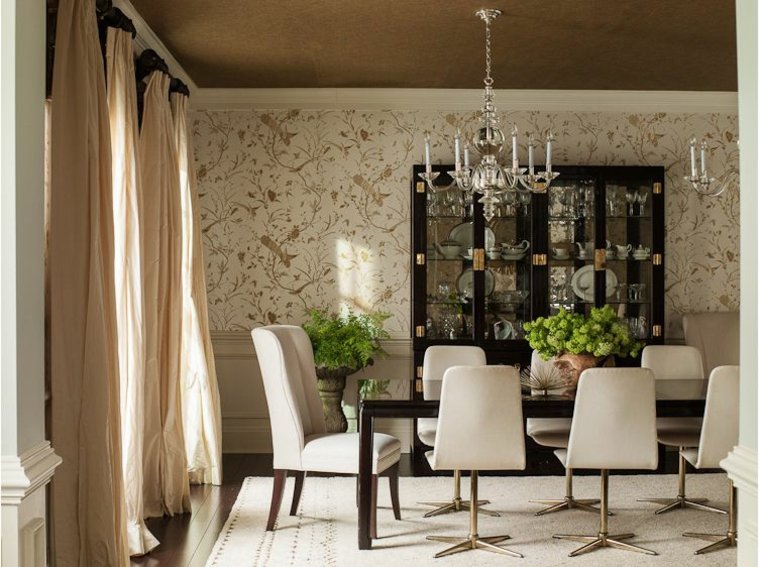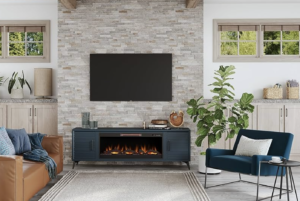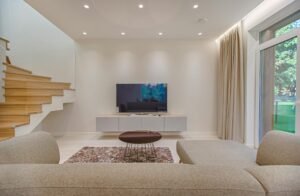
With the help of wallpaper you can add color, style or texture and transform the atmosphere of an interior. Today we are going to talk about decorative wall paper for the dining room. The last few years have seen very original and innovative wallpaper patterns, and everyone who rejected it in the 90s and went out of their way to try to remove the wallpaper from the walls of the living room, dining room and kitchen are now buying new patterns.
Decorative wall paper for living room

Nor can we speak of a resurgence of decorative wallpaper in interior design, but it can be said that many designers use it to create wonderful spaces. Adding it to the dining room is one of the easiest ways to see how your wallpaper looks and if you really like it before trying it in the bedroom or living room.

A dining room is a great place to experiment with decorative wallpaper, especially if you are lucky enough to have a separate room to create the perfect setting for family lunches and dinners.
Liven up the walls with decorative Victorian-style wallpaper

A separate dining room can support a bold wallpaper choice, so be brave with your choice of colors and patterns and don’t be afraid to experiment. There are many types of wallpaper to choose from, including traditional designs like damasks and stripes to create an elegant feel through bright florals or geometric patterns for a more modern touch.

If you choose a dark-colored decorative wallpaper design, coordinate it with a contrasting color on the ceiling, wooden furniture, and pair with white dinnerware and glassware to lift the scheme. The same goes for a bold pattern option, as you don’t want to overwhelm the dining room.

When in doubt, wallpaper a feature wall and keep the rest of the room simple, but tie the scheme together with a similar fabric on window blinds or drapes or tablecloths. Take a look at the dining rooms we have selected for you today that offer a coordinated selection and can help you when using this material in the dining room.

For spaces with an open plan design it is a bit more difficult to try to choose wallpaper, since many designs are not suitable for hot and humid kitchens.

Try zoning the room by wallpapering the area that is used as a dining space and painting or tile the kitchen area in a complementary color. Again tie the scheme together with fabric or kitchen accessories that use the same color in both parts of the room.

The dining room is one of the places in the home where we spend a great deal of time, so it is normal to want it to look absolutely good just like the other rooms in the house. And as in so many other rooms such as the bedroom and the bathroom that come to mind, the dining room is also mainly defined by the furniture that we put in it.

After all, what would a dining room be without a dining table or dining chairs? Because of this, when we start planning to get the most out of this space, we tend to think first in terms of furniture.

But we can use decorative wallpaper to add the wow factor to our dining room, so inspire with our ideas on how you can transform your dining space in an instant.

In general, many of us see our dining rooms as relaxing spaces, this is probably the main reason we avoid the use of wallpaper as we are concerned that the colors and patterns are too strong.

The fact is, however, that not all wallpapers have a pattern and color that dominates a space, and even when there is a striking pattern and when the right shades are used, wallpaper can be used to almost any environment.

Another way to use your wallpaper pattern in a productive way when designing a room is to get creative about where you apply it. For example, the pattern on the walls can also be applied to the backs of chairs, creating a layered look that emphasizes the curves of the pattern. Again, a balanced neutral color palette will help you create visual interest without cluttering the space.

Far from dominating the space, a light or neutral colored wallpaper enhances the feel of the room, creating the perfect backdrop for the style of a bold colored table and chairs. And while it features a host of patterns, the white and gold color palette lets you blend seamlessly for a cohesive and pleasing look.

Instead of painting a pattern on the ceiling and using the wallpaper on the walls, consider placing wallpaper on the ceiling to create an unexpected design in the dining room. In such a case, do not forget to use a neutral rug, without a pattern, white, that contrasts with the colors of the ceiling.

While each helps to balance the appearance of the other, the colors of the ceiling can also be reflected in the decorative elements that you will use throughout the room, while for the wall you can use only one color. As a result, the ceiling acts as the foundation for everything else, creating a visible line that is followed throughout the rest of the room.

There are many fun ways to add decorative wallpaper to your current dining room. There are no missing patterns or colors that you can’t choose from. Which allows us to choose one that exactly matches the ready-made design of our dining room. But let’s dig deeper and find out more about adding decorative wallpaper to your dining room design.

You can use wallpaper to enliven white walls – this is an obvious and easy idea for every homeowner, as you can simply cover the walls with the decorative wallpaper of your choice. The wallpaper you choose should not only complement the theme of the room, but should be in sync with the existing decor and accessories.

While wallpapers come in cool or neutral tones these are generally the preferred and easiest option to work with, don’t miss out on adding color to the dining room with wallpaper. As our ideas show, adding decorative wallpaper can be a world of delicious fun!

You can enjoy the beauty of geometric patterns. Retro, mid-century modern, vintage, and art deco, the trend these days is to bring in patterns and designs that were considered fashionable several decades ago.

Take advantage of this change in the decorating cycle and use bold decorative wallpaper with fun geometric patterns to add vintage flair to your dining room setting. These designs also work very well in spaces with a minimalist design.

Despite their relative positions, your walls and floors don’t have to play opposite each other. On the contrary, the subtle connections between them can go a long way in creating a sense of cohesion in your room design. As you can see in the next photo, the blue color of the floor is reflected in the geometric pattern of the walls.

In more colorful spaces, decorative wallpaper can not only increase the vibrancy of the space but also contribute to the theme. In the next photo, the blue wallpaper contrasts with the lightness reflected in the furniture and the carpet.

For those who are ready to adopt both color and pattern on a larger scale, wallpaper is the most natural option to combine both on their walls. In this example, we see a wallpaper used to reinforce a theme, as it blends seamlessly with curtains that come in different shades of the same color.

As we already said, one of the best options for wallpapering in any room, including the dining room, is to go with a geometric design. The hypnotic effect of these patterns can fill a room, allowing colored furniture and other accessories to create luxurious spaces.




